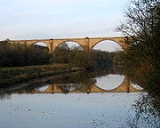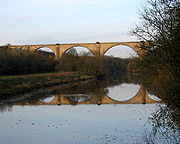
Thomas Elliott Harrison
Encyclopedia

Biography and career
Born in FulhamFulham
Fulham is an area of southwest London in the London Borough of Hammersmith and Fulham, SW6 located south west of Charing Cross. It lies on the left bank of the Thames, between Putney and Chelsea. The area is identified in the London Plan as one of 35 major centres in Greater London...
in London as the son of an employee of Somerset House
Somerset House
Somerset House is a large building situated on the south side of the Strand in central London, England, overlooking the River Thames, just east of Waterloo Bridge. The central block of the Neoclassical building, the outstanding project of the architect Sir William Chambers, dates from 1776–96. It...
, Harrison moved soon after his birth with his family and settled at Fulwell Grange, Monkwearmouth, Sunderland. (A large mansion, now demolished, stood in the grounds of what is now Thompson Park.) Here his father started a shipbuilding yard on the River Wear
River Wear
The River Wear is located in North East England, rising in the Pennines and flowing eastwards, mostly through County Durham, to the North Sea at Sunderland.-Geology and history:...
, but lost his fortune in 1844. After completing his education at the Kepier School in Houghton-le-Spring
Houghton-le-Spring
Houghton-le-Spring is part of the City of Sunderland in the county of Tyne and Wear, North East England that has its recorded origins in Norman times. It is situated almost equidistant between the cathedral city of Durham 7 miles to the south-west and the centre of the City of Sunderland about 6...
, Harrison was apprenticed to Messrs Chapman, engineers and surveyors in Newcastle upon Tyne
Newcastle upon Tyne
Newcastle upon Tyne is a city and metropolitan borough of Tyne and Wear, in North East England. Historically a part of Northumberland, it is situated on the north bank of the River Tyne...
. He showed marked ability and made the acquaintance of George
George Stephenson
George Stephenson was an English civil engineer and mechanical engineer who built the first public railway line in the world to use steam locomotives...
and Robert Stephenson
Robert Stephenson
Robert Stephenson FRS was an English civil engineer. He was the only son of George Stephenson, the famed locomotive builder and railway engineer; many of the achievements popularly credited to his father were actually the joint efforts of father and son.-Early life :He was born on the 16th of...
.
Harrison surveyed part of the London
London
London is the capital city of :England and the :United Kingdom, the largest metropolitan area in the United Kingdom, and the largest urban zone in the European Union by most measures. Located on the River Thames, London has been a major settlement for two millennia, its history going back to its...
-Birmingham
Birmingham
Birmingham is a city and metropolitan borough in the West Midlands of England. It is the most populous British city outside the capital London, with a population of 1,036,900 , and lies at the heart of the West Midlands conurbation, the second most populous urban area in the United Kingdom with a...
line and the Stanhope
Stanhope
-Places:* Stanhope, Victoria, Australia* Stanhope, Prince Edward Island, Canada* Stanhope, Quebec, Canada* Stanhope, County Durham, England, UK* Stanhope, Kent, England, UK* Stanhope, Peeblesshire, Scotland, UK* Stanhope, Iowa, US* Stanhope, New Jersey, US...
and Tyne railway. This latter included the famous Victoria Viaduct
Victoria Viaduct
The Victoria Viaduct, originally called the 'Victoria Bridge', is a rail bridge spanning the River Wear in North East England, carrying the mothballed Leamside Line. The bridge was commissioned by the Durham Junction Railway and designed by Thomas Elliot Harrison. It was based upon the Roman bridge...
at Penshaw
Penshaw
The village of Penshaw , formerly known as Painshaw or Pensher, is an area of the metropolitan district of the City of Sunderland, in Tyne and Wear, England...
, which he planned and supervised. This viaduct is built on the pattern of the Roman bridge
Roman bridge
Roman bridges, built by ancient Romans, were the first large and lasting bridges built. Roman bridges were built with stone and had the arch as its basic structure....
at Alcántara
Alcántara Bridge
The Alcántara Bridge is a Roman stone arch bridge built over the Tagus River at Alcántara, Spain between 104 and 106 CE by an order of the Roman Emperor Trajan in 98...
in Spain
Spain
Spain , officially the Kingdom of Spain languages]] under the European Charter for Regional or Minority Languages. In each of these, Spain's official name is as follows:;;;;;;), is a country and member state of the European Union located in southwestern Europe on the Iberian Peninsula...
. The Penshaw Monument
Penshaw Monument
Penshaw Monument is a folly built in 1844 on Penshaw Hill between the districts of Washington and Houghton-le-Spring, within the City of Sunderland, North East England...
to Lord Durham stands on the hill nearby. As Nikolaus Pevsner
Nikolaus Pevsner
Sir Nikolaus Bernhard Leon Pevsner, CBE, FBA was a German-born British scholar of history of art and, especially, of history of architecture...
says: 'Is there any other place where one can stand beneath a 'Roman' viaduct and see a 'Greek' temple?'
Harrison also surveyed the Newcastle-Carlisle
Newcastle and Carlisle Railway
The Newcastle and Carlisle Railway, occasionally referred to as the Tyne Valley Line, is a railway line in northern England. The line was built in the 1830s, and links the city of Newcastle upon Tyne in Tyne and Wear with in Cumbria. Formal opening took place on 18 June 1838.The line follows the...
line and a number of other lines. With Robert Stephenson
Robert Stephenson
Robert Stephenson FRS was an English civil engineer. He was the only son of George Stephenson, the famed locomotive builder and railway engineer; many of the achievements popularly credited to his father were actually the joint efforts of father and son.-Early life :He was born on the 16th of...
he worked on the High Level Bridge
High Level Bridge
The High Level Bridge is a road and railway bridge spanning the River Tyne between Newcastle upon Tyne and Gateshead in North East England.-Design:...
at Newcastle, and when Stephenson retired as railway engineer, Harrison took over as engineer-in-chief of the York
York
York is a walled city, situated at the confluence of the Rivers Ouse and Foss in North Yorkshire, England. The city has a rich heritage and has provided the backdrop to major political events throughout much of its two millennia of existence...
-Newcastle-Berwick line, where he deployed considerable powers of organisation. At the 1849 dinner in Newcastle Central Station to celebrate the completion of this line, Stephenson said:
In 1858, Harrison designed and carried out the Jarrow
Jarrow
Jarrow is a town in Tyne and Wear, England, located on the River Tyne, with a population of 27,526. From the middle of the 19th century until 1935, Jarrow was a centre for shipbuilding, and was the starting point of the Jarrow March against unemployment in 1936.-Foundation:The Angles re-occupied...
docks project, using a number of remarkable hydraulic devices, and also designed the Hartlepool
Hartlepool
Hartlepool is a town and port in North East England.It was founded in the 7th century AD, around the Northumbrian monastery of Hartlepool Abbey. The village grew during the Middle Ages and developed a harbour which served as the official port of the County Palatine of Durham. A railway link from...
docks. He became president of the Institution of Civil Engineers
Institution of Civil Engineers
Founded on 2 January 1818, the Institution of Civil Engineers is an independent professional association, based in central London, representing civil engineering. Like its early membership, the majority of its current members are British engineers, but it also has members in more than 150...
in 1873. He died at home in Whitburn
Whitburn, South Tyneside
Whitburn is a village in South Tyneside, on the coast of North East England. It lies just to the north of the City of Sunderland in the ceremonial county of Tyne and Wear. Until 1974, when the Local Government Act 1972 came into being, it was part of County Durham...
. At the time he was very much involved in the designs for the Forth Bridge
Forth Bridge (railway)
The Forth Bridge is a cantilever railway bridge over the Firth of Forth in the east of Scotland, to the east of the Forth Road Bridge, and 14 kilometres west of central Edinburgh. It was opened on 4 March 1890, and spans a total length of...
.

